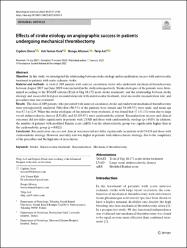| dc.contributor.author | Deniz, C. | |
| dc.contributor.author | Kula, A.Y. | |
| dc.contributor.author | Altunan, Bengü | |
| dc.contributor.author | Asil, T. | |
| dc.date.accessioned | 2022-05-11T14:05:05Z | |
| dc.date.available | 2022-05-11T14:05:05Z | |
| dc.date.issued | 2022 | |
| dc.identifier.issn | 1590-1874 | |
| dc.identifier.uri | https://doi.org/10.1007/s10072-022-05892-5 | |
| dc.identifier.uri | https://hdl.handle.net/20.500.11776/4888 | |
| dc.description.abstract | Objective: In this study, we investigated the relationship between stroke etiology and recanalization success with endovascular treatment in patients with acute ischemic stroke. Material and methods: A total of 109 patients with anterior circulation stroke who underwent mechanical thrombectomy between August 2017 and June 2019 were included in the study retrospectively. Stroke etiologies of the patients were determined according to the TOAST criteria (Trial of Org 10,172 acute stroke treatment), and the relationship between stroke etiology and successful first-pass recanalization rate with endovascular treatment, total successful recanalization rate, and procedure time was evaluated. Results: The data of 109 patients who presented with anterior circulation stroke and underwent mechanical thrombectomy were retrospectively analyzed. Fifty-five (50.5%) of the patients were female and 54 (49.5%) were male, and mean age was 67.3 ± 12.9. When the stroke etiologies of the patients were evaluated, it was found that 47 (43.1%) were due to large vessel ateherosclerotic disease (LVAD), and 62 (56.9%) were cardioembolic-related. Recanalization success and clinical outcomes did not differ significantly in patients with LVAD and those with cardioembolic etiology (p > 0.05). In addition, the number of patients with modified Rankin score (mRS) 6 in the atherosclerotic group was significantly higher than in the cardioembolic group (p = 0.022). Conclusion: Recanalization success and clinical outcomes did not differ significantly in patients with LVAD and those with cardioembolic etiology. However, mortality rate was higher in patients with atherosclerotic etiology, due to the complexity of the procedure and the high rate of reocclusion. © 2022, Fondazione Società Italiana di Neurologia. | en_US |
| dc.language.iso | eng | en_US |
| dc.publisher | Springer-Verlag Italia s.r.l. | en_US |
| dc.identifier.doi | 10.1007/s10072-022-05892-5 | |
| dc.rights | info:eu-repo/semantics/closedAccess | en_US |
| dc.subject | Endovascular treatment | en_US |
| dc.subject | Mechanical thrombectomy | en_US |
| dc.subject | Recanalization | en_US |
| dc.subject | Stroke | en_US |
| dc.title | Effects of stroke etiology on angiographic success in patients undergoing mechanical thrombectomy | en_US |
| dc.type | article | en_US |
| dc.relation.ispartof | Neurological Sciences | en_US |
| dc.department | Fakülteler, Tıp Fakültesi, Dahili Tıp Bilimleri Bölümü, Nöroloji Ana Bilim Dalı | en_US |
| dc.institutionauthor | Deniz, C. | |
| dc.institutionauthor | Altunan, Bengü | |
| dc.relation.publicationcategory | Makale - Uluslararası Hakemli Dergi - Kurum Öğretim Elemanı | en_US |
| dc.authorscopusid | 56732770100 | |
| dc.authorscopusid | 57418413000 | |
| dc.authorscopusid | 57211906388 | |
| dc.authorscopusid | 8921557300 | |
| dc.identifier.wos | WOS:000743424500004 | en_US |
| dc.identifier.scopus | 2-s2.0-85123124411 | en_US |



















